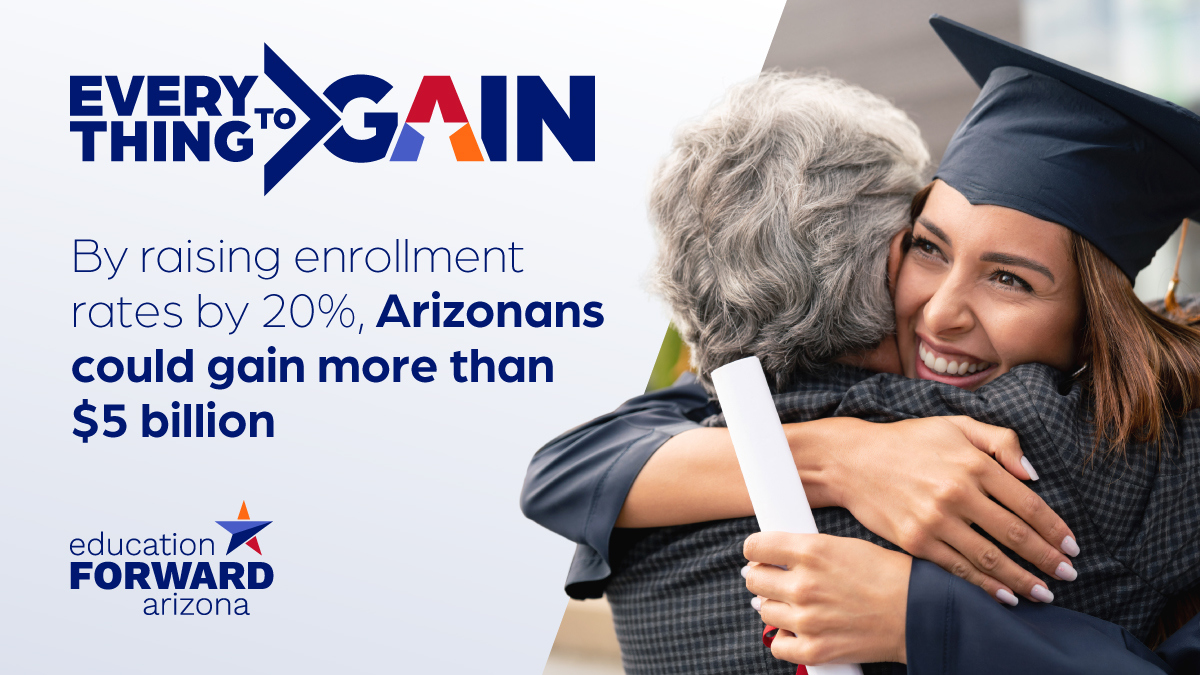The need for skilled labor and specialized training remains high. In Arizona, nearly 7 out of 10 jobs require training beyond high school. Yet, approximately 25 percent of eligible high school graduates do not pursue a college education.
As a result, Arizona is facing a shortage of individuals with college-level qualifications. More than half of Arizonans aged 25 to 64 do not hold a postsecondary degree or professional certification, putting Arizona’s attainment rate at 48 percent—one of the lowest in the nation.
The causes for the shortage stem from a variety of factors. Arizona students are falling behind at multiple points in the preK-12 pipeline. Currently, only 35 percent of third graders in Arizona are proficient in reading and just 27 percent of eighth graders are considered prepared for high school math, much lower than the state goal of 69 percent. This increases the difficulty to succeed in higher grades, and in turn, leads to lower graduation rates.
The cost of attending college also continues to rise. In-state tuition averages over $12,000 per year for Arizona’s three public universities. When compounded with the rising cost of living, inflation and lack of support to pay down student loans post-graduation, some students are viewing college as a financial risk rather than a personal investment.
Although the initial cost of post-secondary education can seem daunting or unattainable for some, it does not compare to the loss of an individual’s lifetime earning potential and other benefits they may experience if they choose not to continue their education.
According to the recent Billions to Gain report published by Education Forward Arizona and the Helios Education Foundation, Arizonans who complete a 4-year degree have the potential to earn $800,000 more in their lifetime than high school graduates. The difference is over $1 million for those with advanced degrees. In turn, these higher earners also contribute nearly $1 million more in lifetime social gains related to earnings, health, public benefits and workforce productivity.
Arizona’s social and fiscal gains trend upward as college attainment increases. If Arizona is able to increase college attainment and completion by 10 percent, the state could see a $1.37 billion increase in economic gains per cohort. Gains more than triple when attainment increases by 20 percent and the fiscal gains at that level from higher tax revenues and decreased public spending are double what was allocated for the public universities in the 2022 General Fund Budget.
It’s clear that Arizona needs to push for a more educated populace to achieve prosperity for individuals and the economy. This summer, Education Forward Arizona and a network of advocates and partners have rallied around the Everything to Gain campaign that is encouraging Arizonans to add over 500,000 degrees and certificates by 2030, a goal that’s in alignment with the state’s Achieve60AZ Action Plan to achieve 60 percent college attainment by the same year.
To maximize gains across Arizona, the Everything to Gain campaign partners are committed to convening key stakeholders to improve systemic issues statewide that are keeping students from pursuing higher education. This includes pushing for more affordable education and expanding scholarship programs, increasing support for educators, and establishing tools to ensure college preparedness.
To join the effort or learn more about the Everything to Gain campaign and the Billions to Gain report, visit www.educationforwardarizona.org.
Melissa L. Boydston, Ed.D, is the senior vice president of community development and engagement at Valley of the Sun United Way. To learn more about Valley of the Sun United Way and its journey to create Mighty Change by 2026, visit www.vsuw.org/MightyChange.

